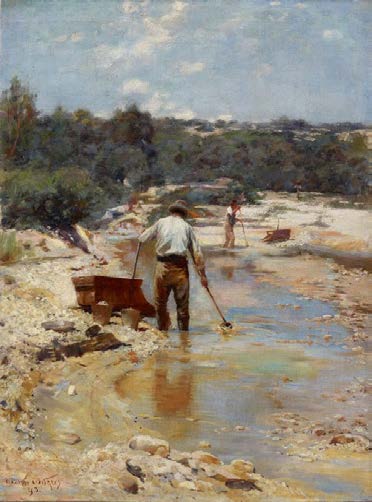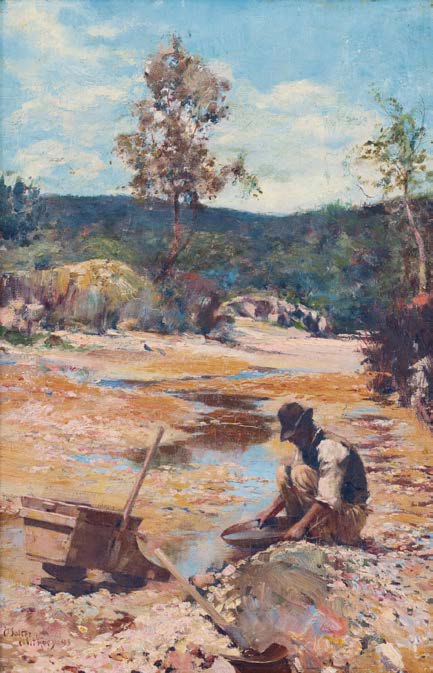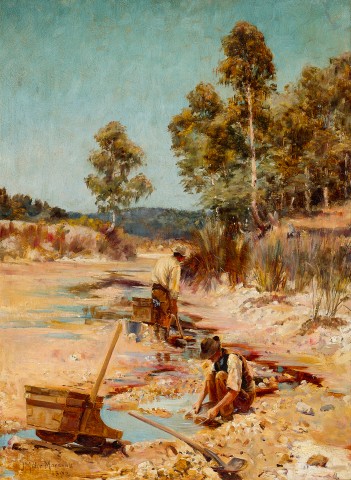Gold prospecting, near Creswick, 1892
James Miller marshall
oil on board
55.5 x 40.5 cm
signed and dated lower left: J Miller Marshall / 1892
bears inscription verso: Prospecting for Gold / on the Gold Creek nr Creswick + Ballarat
Private collection
Sotheby's, Chester, England, February 1986
Private collection
Deutscher Fine Art, Melbourne
Private collection, Melbourne, acquired from the above in April 1986
Australian Art: Colonial to Modern, Deutscher Fine Art, Melbourne, 9 - 25 April 1986, cat. 52 (as 'Gold Prospecting, near Creswick, Ballarat')
Ingram, T., 'Even in Chester they holler for a Marshall', The Australian Financial Review, 27 March 1986, p. 38 (as 'Gold Prospecting, near Creswick, Ballarat')
Topliss, H., The Artist Camps: ‘Plein Air’ Painting in Australia, Hedley Australia Publications, Melbourne, 1992, pl. 17, pp. 20 (illus. as 'Gold Prospecting, near Creswick, Ballarat'), 186
Fossicking for Gold, 1893, oil on canvas laid down on board, 44.0 x 33.0 cm, private collection, Victoria
Walter Withers, Seeking for gold - cradling, 1893, oil on canvas on hardboard, 67.0 x 49.6 cm, Art Gallery of New South Wales, Sydney
1.jpg

Australian art history is replete with evocative stories of artists living and working together in the landscape. Think, for example, of the camaraderie of Australian Impressionists Tom Roberts, Arthur Streeton and Louis Abrahams at the plein air painting camp at Box Hill in the summer of 1885, or of Curlew Camp on Sydney’s North Shore, where in the early 1890s Roberts and Streeton found creative inspiration in their rustic but picturesque ocean-side accommodation. Painting outdoors, these artists captured the effects of light and colour at different times of the day and in different seasons, communicating both the appearance and the experience of their landscape subjects.
Walter Withers met Roberts, Abrahams and Frederick McCubbin as a student at Melbourne’s National Gallery school and he too was an artist ‘who went out [in]to nature, and made successful attempts to represent her varying moods.’1 In 1893, he and his friend James Miller Marshall were invited to Creswick, a town not far north of Ballarat, to teach a summer school. ‘[They] spent several weeks… holding an out-of-door class during the month of January. Creswick, with its Italian colouring of blue and gold, made an ideal painting ground, and the students were enthusiastic workers. Amongst those who took advantage of this opportunity were Percy Lindsay (then a promising young landscape painter), and, at the evening drawing class held in the [Ballarat] School of Mines, his young brother, now the well-known Norman Lindsay – a schoolboy then, whose remarkable facility in drawing aroused Withers’ wonder and delight.’2
2.jpg

English born, Marshall was the son of a painter who ‘received his early training as an artist at the South Kensington school, but as soon as he had acquired a sufficient grounding in the technical knowledge of drawing and painting… followed the example of the great French and English artists of the new school, painting and studying direct from nature.’3 He exhibited a series of landscapes at the Royal Academy of Art in London during the 1880s before travelling to Australia in 1890. While he primarily painted in and around Melbourne, Sydney Harbour from the Domain, 1893, a watercolour in the collection of the National Gallery of Victoria, suggests that he also ventured further north during his years in Australia. Another Lindsay brother, Lionel, who also undertook art classes with Marshall in Creswick described him fondly as a ‘big, bearded simple soul who asked from life a full day’s painting and a pot of beer at eve on an ale-house bench’, and recalled his advice, ‘Plenty of water. Plenty of water and a full brush: that’s the secret of watercolour.’4
3.jpg

One of the notable outcomes of this summer in Creswick was a series of paintings by Marshall, Withers and Percy Lindsay which depict miners fossicking for gold. Among them, a trio of closely related paintings includes this work by Marshall, Withers’ Panning for gold, 1893 and Lindsay’s Fossicking for gold, 1894 (both private collection). Withers and Lindsay depict a lone prospector kneeling beside a shallow creek panning for gold with a cradle – a wooden sieve used to separate alluvial gold from washed soil – and other tools of the trade nearby. Both artists use the familiar blue and gold palette of the Impressionist landscape and emphasise space and distance, describing the long meandering path of the creek towards faraway hills. Marshall’s painting is the largest of the three and depicts two prospectors at work. His colouring is more sombre, with a moody sky above the creek and rocky ground, which is painted in rich shades of burgundy, brown and blue. The pictorial space of Marshall’s picture is also more condensed and perhaps, as a visitor to the country who was unfamiliar with the native flora, he pays particular attention to the depiction of the reedy growth along the creek edge and the gum trees, carefully describing the distinctive drooping habit of their foliage. Fossicking for gold, 1893, now in the collection of the National Gallery of Australia, is one of at least two other related works that Marshall painted at the time.
The discovery of gold in the 1850s transformed the Australian colonies, drawing huge numbers of migrants from across the world who travelled to the goldfields eager to find their fortune. The settler population more than quadrupled in the decades between 1851 and 1871, with many arriving in Victoria where, in the first decade of the gold rush, more than a third of the world’s gold was found. Although the peak of the Victorian gold rush was over by the 1890s, as these paintings demonstrate the subject of miners at work in the landscape continued to be one that interested contemporary painters.
1. ‘Art of Walter Withers’, The Argus, Melbourne, 29 July 1919, p. 6
2. McCubbin, A., The Life and Art of Walter Withers, Alexander McCubbin, Melbourne, 1919, p. 19
3. Table Talk, 24 June 1898, cited in Ingram, T., ‘Even in Chester they holler for a Marshall’, The Australian Financial Review, 27 March 1986, p. 38
4. Lionel Lindsay, cited in Clifford-Smith, S., biography of J. Miller Marshall, Design & Art Australia Online, at: https://www.daao.org.au/bio/version_history/j-miller-marshall-1/biography/ (accessed 23 September 2025)
KIRSTY GRANT


